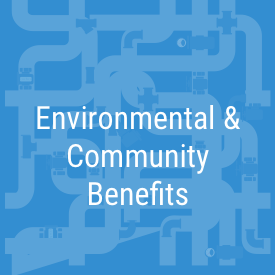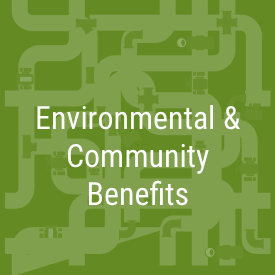This project continues to build and update watershed data to track stream ecosystem conditions, helping Valley Water and other county agencies and organizations make informed watershed, asset management and natural resource decisions. The new and updated information will be used to develop or modernize integrated watershed plans (such as watershed profiles, One Water Plan and Stream Corridor Priority Plans) that identify potential projects, support grant applications, environmental analyses and permits, and are shared with land use agencies, environmental groups, and the public to make efficient and coordinated environmental decisions throughout the county. These data and plans will help integrate and enhance Valley Water’s programs, projects, maintenance and stewardship actions through standardized, repeatable and defensible measurements that guide, organize and integrate information on stream and habitat conditions.
Measuring changes in ecological conditions through time allows Valley Water, resource agencies, land managers and the public to understand and respond to climate change effects and evolving creek and habitat conditions.








KPI #1: Reassess and track stream ecological conditions and habitats in each of the county’s five (5) watersheds every 15 years.
The Guadalupe River watershed reassessment report, including the results of the reassessment data collection and a comparison with the 2012 assessment, was completed in June 2024.
Preparations are being made to undertake the Upper Pajaro River watershed reassessment in summer 2025.
Valley Water uses the California Rapid Assessment Method (CRAM) to assess the ecological condition of creeks in Santa Clara County’s five major watersheds and document changes over time. You can learn more about the methodology at cramwetlands.org. The CRAM scores that form the basis of the watershed assessments, and for numerous County creeks, lakes, and wetlands, can be accessed on EcoAtlas.
KPI #2: Provide up to $500,000 per 15-year period toward the development and updates of five (5) watershed plans that include identifying priority habitat enhancement opportunities in Santa Clara County.
Valley Water is working with the San Francisco Estuary Institute/Aquatic Science Center (SFEI-ASC) to develop Phase 1 of the Upper Pajaro Native Ecosystem Enhancement Tool (UPNEET). UPNEET builds from the recently finalized One Water watershed plan for the Upper Pajaro River Watershed to identify more detailed habitat enhancement action and opportunity area assessment and mapping, and utilizes the platform, programming, and structure of the Coyote Creek Native Ecosystem Enhancement Tool (CCNEET – see below for more details). In the first quarter of FY25, Valley Water conducted numerous internal and external stakeholder meetings to receive input on objectives and data sources, while SFEI-ASC worked on programming the beta version of the tool.
Project D5 continues to help maintain and update the Coyote Creek Native Ecosystem Enhancement Tool (CCNEET), an online decision-support tool to identify and coordinate habitat actions to improve ecological conditions along Coyote Creek, from Anderson Dam to Montague Expressway. Inspired by the need for a watershed approach to environmental resource management, project planning, and permitting, an overarching goal of CCNEET is to help coordinate habitat conservation and enhancement so that multiple projects and limited funding can result in meaningful ecological improvement of the creek. You can learn more about CCNEET here and request access from the project contact listed on this page.
November 2024
The best of Santa Clara County's native vegetation!
Valley Water completed a detailed documentation of the composition and conditions of Santa Clara County’s most pristine native plant communities. The study included numerous regionally native vegetation communities, with an emphasis on wetland and riparian habitats. At over 300 sample plots, the Vegetation Rapid Assessment method (modified from California Native Plant Society 2018 online at https://www.cnps.org/plant-science/field-protocols-guidelines) was used to document plant species, percent cover, and key physical conditions, and vegetation classified under the Manual of California Vegetation (Sawyer et al. 2009 online at https://vegetation.cnps.org/). This understanding improves restoration and mitigation project designs and success, helps standardize permit conditions, and increases climate resiliency of projects. While the study method details, data analyses, and results are still being prepared, we are excited to share the study’s raw data here. Please direct any questions to the project contact listed on this page, and stay tuned for the accompanying report.
Baseline Assessments
The first, or baseline, assessments of stream ecological condition in each of Santa Clara County’s five major watersheds are available:
- Coyote Creek (2010) including Upper Penitencia Creek
- Guadalupe River (2012) urban and non-urban
- Lower San Francisco Bay peninsula creeks in Santa Clara County (2016) including San Francisquito, Adobe, and Stevens-Permanente creeks
- Pajaro River in Santa Clara County (2015) including Pacheco, Llagas, and Uvas creeks
- West Valley Watershed (2018) including Sunnyvale, Saratoga-San Tomas Aquino and Calabazas creeks
Synthesis report of stream ecological condition in all five of Santa Clara County’s major watersheds (2020), with comparisons between the watersheds and with statewide and San Francisco Bay Delta ecoregion. Examples applying CRAM to project and mitigation performance, and a watershed approach are also provided.
2015 State of the Estuary overview poster: Stream health of the Coyote Creek and Guadalupe River watersheds using California's Wetland and Riparian Area Monitoring Plan (WRAMP).
2017 presentation: Using the California Rapid Assessment Method (CRAM) to Quantify Riverine Riparian Condition in Santa Clara County Watersheds.
Watershed Reassessment Reports
The reassessment of stream ecological condition in the Coyote Creek watershed (2020), includes a comparison with the 2010 results.
The reassessment of stream ecological condition in the Guadalupe River watershed (2022), includes a comparison with the 2012 results.
Related Information:
- Using the California Rapid Assessment Method (CRAM) for project assessment as an element of regulatory, grant, and other management programs (2019 Technical Bulletin), including guidance for regulatory/permitting compliance.
-
The Healthy Watersheds Partnership is devoted to monitoring and assessing the quality of California’s stream and river ecosystems, and bringing the resulting information to decision makers and the public.
-
2013 California Integrated Assessment of Watershed Health report by the US EPA Healthy Watersheds Protection.
-
2015 Perennial Streams Assessment (PSA) by CA State Water Resources Control Board, Surface Water Ambient Monitoring Program (SWAMP).
-
2015 California Stream Condition Index (CSCI) SWAMP stream health and CSCI Scores Map.
-
2015 California Central Coast Healthy Watersheds Project report card with trend analysis. For data and other information, see the Central Coast Regional Water Quality Control Board's Central Coast Ambient Monitoring Program (CCAMP), including the Pajaro River, Uvas-Carnadero and Llagas Creeks.
-
California Environmental Data Exchange Network (CEDEN) is a central location to find and share information about California’s water bodies, including streams, lakes, rivers, and the coastal ocean. CEDEN aggregates data and makes it accessible to environmental managers and the public.
- United States Geological Survey (USGS) California Stream Quality Assessment (CSQA)
Key Performance Indicators (FY22–36)
-
Reassess and track stream ecological conditions and habitats in each of the county’s five (5) watersheds every 15 years.
-
Provide up to $500,000 per 15-year period toward the development and updates of five (5) watershed plans that include identifying priority habitat enhancement opportunities in Santa Clara County.
Benefits
-
Improves natural resource, watershed and asset management decisions
-
Provides a systematic, scientific guide for decisions and actions to improve stream conditions
-
Supports effective and environmentally sound design options
-
Provides reliable data on countywide stream conditions and basis for measuring the success of past mitigation and environmental stewardship project projects
-
Facilitates a watershed approach to resource management, permitting and restoration planning
-
Supports climate change adaptation by providing data to better understand its effects on local habitats to enable increased habitat resiliency
Geographic Area of Benefit
Countywide
About the Safe, Clean Water and Natural Flood Protection Program
In November 2020, voters in Santa Clara County overwhelmingly approved Measure S, a renewal of Valley Water’s Safe, Clean Water and Natural Flood Protection Program.
The program was first passed by voters in 2000 as the Clean, Safe Creeks and Natural Flood Protection Plan, then again in 2012 as the Safe, Clean Water and Natural Flood Protection Program. The renewal of the Safe, Clean Water Program will continue to provide approximately $47 million annually for local projects that deliver safe, clean water, natural flood protection, and environmental stewardship to all the communities we serve in Santa Clara County.
While evaluating ways to improve the 2012 program, Valley Water gathered feedback from more than 21,000 community members. That helped Valley Water create the six priorities for the renewed Safe, Clean Water Program, which are:
Priority A: Ensure a Safe, Reliable Water Supply
Priority B: Reduce Toxins, Hazards and Contaminants in our Waterways
Priority C: Protect our Water Supply and Dams from Earthquakes and Other Natural Disasters
Priority D: Restore Wildlife Habitat and Provide Open Space
Priority E: Provide Flood Protection to Homes, Businesses, Schools, Streets and Highways
Priority F: Support Public Health and Public Safety for Our Community
Each year, Valley Water prepares a report providing a progress update for each of these program priorities, along with fiscal year accomplishments.
To ensure transparency and accountability to the voters, the ballot measure also created an Independent Monitoring Committee, appointed by the Santa Clara Valley Water District Board of Directors. The Independent Monitoring Committee annually reviews the program’s progress to ensure the outcomes are achieved in a cost-efficient manner and reports its findings to the Board. Additionally, the IMC also reviews each proposed 5-year implementation plan prior to its submittal for Board approval.
In addition, the program requires three independent audits.







